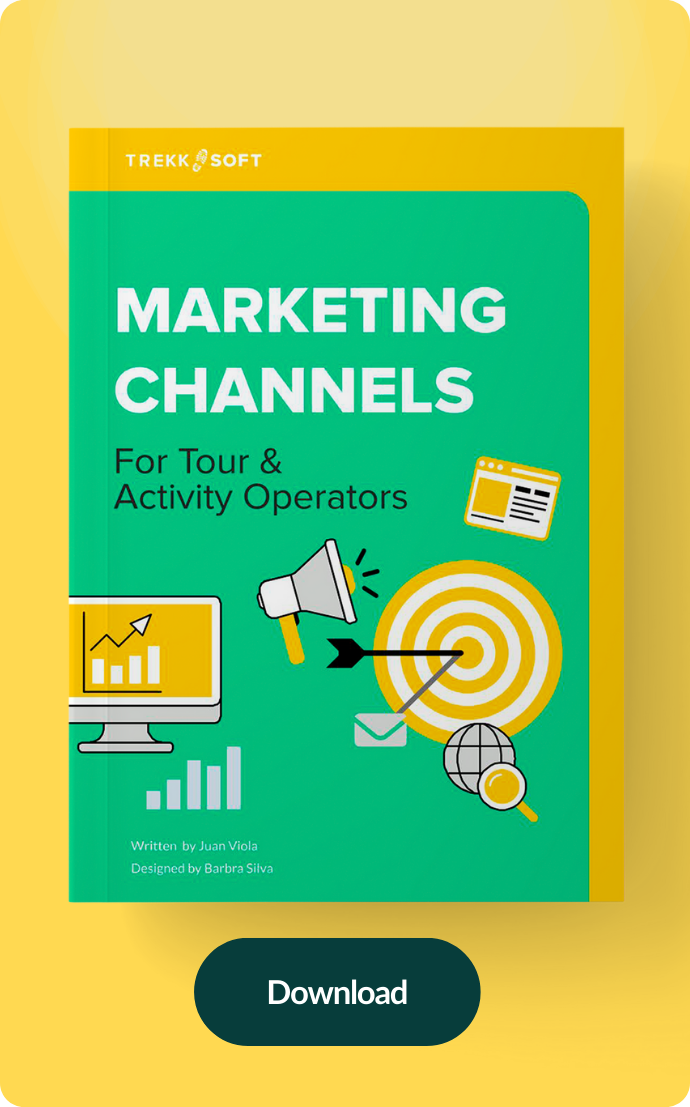Initially posted in 2016, this content has been updated for enhanced relevance, with the changes effective as of August 25, 2023. It was originally contributed by TrekkSoft as America Outdoor Association's Monthly Marketing tip. For more tips, you can also check out our SEO ebook.
The key to a well-ranking website isn't making nifty technical adjustments as perhaps once thought but creating "the best possible experience for your audience with original and high-quality content". This is according to the leader of the online search: Google.
Ranking higher in search engines, such as Google, Bing, Yahoo!, Baidu, etc., offers tour and activities operators many benefits.
- It helps to increase organic website traffic. As your content climbs the search results, it becomes more accessible to a broader audience actively seeking information or solutions related to your niche.
- Increase your brand awareness, and generate more leads and potential customers. Having a page high in positions - at the top 10 pages shown in a search - fosters credibility and trust among users; being featured prominently suggests to searchers that your content is authoritative and relevant.
- Ultimately, achieving a top position in search engine results nurtures a virtuous cycle of visibility, engagement, and growth for your online presence.
While working with SEO might feel overwhelming for those starting, keep in mind that, in 2022, over 50% of small businesses don't have an SEO strategy, so you can get ahead of your competitors by applying effective SEO strategies.
In this article, we'll cover how to boost SEO (search engine optimization) with techniques that you can apply to your tourism business, such as using the right keywords for your business, Creating High-Quality Content, Optimizing Meta titles, meta descriptions, and images, Link Building (Internal and External Linking) and Mobile-Friendly and Page Speed.

1. Use the right keywords for your business with Keyword Research
Effective keyword research forms the cornerstone of a successful SEO strategy for your tourism business. By understanding the significance of keyword research, you can tailor your content to match the needs and preferences of your target audience, for example:
- You can reach a tourist searching for their next destination with keywords such as “best beaches to visit in the summer” or “best historical sites to visit in Europe.”
- When the tourist is in their planning stage, so they have decided on the destination and are now looking for flights, accommodations, and activities, you can work with keywords that are more direct to your location. E.g. “Best places to eat in Milan” “What to do in Rome in December”.
You can learn more about how to build an effective marketing funnel for tour and activity operators here.
Here are some tools you can use to choose the best keywords for tour operators:
- Google Trends. Google Trends is a tool that tells you how much people are interested in specific topics. You can see if more or fewer people search for a word or topic over time. It helps you figure out what's popular right now and where.
- Google Keyword Planner. Think of Google Keyword Planner as a helper that gives you ideas for words to use on your website. It shows how often a word is searched for and how many other websites use it. This can help you choose words many people search for but aren't used too much by other websites.
- Ubersuggest gives you lots of ideas for words to use. It also tells you how many times people search for those words. It's like having a friend who knows what people like to search for. Simply enter a keyword, and Ubersuggest will show you a list of related keywords, search volume, and even backlink data for top-ranking pages.
- Semrush is a tool that shows you what words your competition uses on their websites. It's like peeking at what your neighbours are doing to get more visitors. You can also find out if a word is easy or hard to use based on how many other websites use it.
- Answer the Public helps you discover people's questions and queries about your keyword. Enter a keyword, and the tool generates a visual representation of questions, prepositions, and comparisons related to that keyword. This can guide you in creating content that addresses specific user queries.
These tools enable you to identify the most relevant and high-impact keywords that align with your tourism offerings. By focusing on search intent, you can predict what your potential customers are searching for and create content that precisely meets their requirements.
Implementing these carefully selected keywords in strategic locations, including titles, headings, and the body of your content, ensures that search engines recognize and index your content accurately. This strategic keyword placement increases the visibility of your tourism business, driving organic traffic and enhancing your online presence within the competitive travel industry.
2. Creating high-quality content
High-quality content is information that's accurate, engaging, and genuinely helpful to people. It's like creating a practical guide that people enjoy reading. Having well-written and enveloping content is essential because it's like speaking clearly and confidently, making people trust what you're saying. You can learn more about how to tell stories that engage your audience in our blog 10 steps to mastering the art of storytelling.
Additionally, high-quality content goes beyond just sharing information – it's about solving problems. Think of it as the hero who helps people with questions and challenges. When your content provides practical tips and solutions, it's like giving someone a valuable tool to fix things. Ultimately, creating top-notch content is like being a friendly and knowledgeable guide who's always ready to help others on their journey.
Read Website conversion optimization for tour businesses.
3. Optimizing meta title, meta description, and images
When it comes to making your website more visible on the internet, there are a few things you can do that work, like signs to guide people and search engines. These things are called meta tags, and they're like labels that tell everyone what your content is about. The most important ones are the meta title and meta description.
The meta title is the title of your content – it tells people what they can expect to find in your content. It needs to be exciting and straightforward and have the main idea of your content and a keyword or two. This helps search engines understand what your page is about.
Now, the meta description is like a summary of your content. It's a short and comprehensive explanation that gives people a sneak peek into what they'll discover if they click on your page. Make it engaging and descriptive so that people feel curious to learn more.
And let's remember images! Not only do they make your content more interesting and easier to read, but they can also have some hidden information. You can add "alt text" to images, like a short picture description. This helps search engines know what the image is showing, and it's also useful for people who use screen readers because they can't see the pictures.
By getting these things right – meta titles, meta descriptions, and images – you're helping your content shine and stand out online.
4. Link building (internal and external linking)
Imagine your website is a big building, and each piece of content is a different part floor. Link building is like adding little paths that connect these floors. These paths help people and search engines find their way around your website.
Incorporating internal links to relevant pages
When you have a piece of content, you can add links to other related articles on your website. It's like saying, "Hey, if you want to know more about this, check out this cool thing we wrote!" These internal links make it easier for people to explore more of your website and understand what you offer. Internal links help you in many ways, such as:
- Improved Navigation. Internal links help visitors move smoothly between different sections of your website. This keeps them engaged and encouraged to explore more of your content.
- Distribute Authority. Search engines use internal links to understand the structure and hierarchy of your site. Frequently linked pages are considered more important and relevant, boosting their search ranking.
- Reduced Bounce Rate. If someone lands on a page through a search engine but doesn't find what they need, they might leave quickly. Internal links can direct them to related, interesting content, reducing the likelihood of them leaving immediately.
- Boosted SEO. When you internally link to other pages using relevant keywords as anchor text, it helps search engines understand the topic of the linked page, which can positively impact your SEO efforts.
Using authoritative sources for external links
External links are like roads that lead from your website to other websites. When you link to an external source, you're directing your visitors to additional, credible information not on your site. Some of the benefits of external links are:
- Credibility and Authority. When you link to well-established, authoritative sources, it shows that you've done your research and you're providing valuable information.
- Building Relationships. Linking to other websites can initiate a positive relationship. If they notice your link and find it helpful, they might link back to your content in the future, boosting your website's visibility.
- Enhanced User Experience. By providing external links, you're helping your readers access more in-depth information if they're interested.
- Avoiding Plagiarism. If you're referencing someone else's work or data, linking to their content is essential. This not only gives proper credit but also avoids plagiarism issues.

5. Mobile-friendly and page speed
A mobile-friendly website and ensuring fast page loading are crucial for a successful online presence and improved SEO. When mobile-friendly, users can access and navigate your website seamlessly on various devices, including smartphones and tablets. This enhances user experience and reduces bounce rates, positively impacting your search engine rankings.
A mobile-friendly website means that when someone opens it on their phone or tablet, it looks as good as on a big computer screen. This is crucial because if your website is hard to use on a phone, people might leave and find another site that's easier to navigate. Keep in mind that, according to Think with Google, travelers most frequently use their mobile devices to research activities or attractions, to locate shopping areas and restaurants, or to look up directions.
For a mobile-friendly experience, your website needs a responsive design, a way of building your site that automatically adjusts to different screen sizes. So, whether someone's looking at your site on a computer, a phone, or a tablet, it still looks nice and works well. This keeps your visitors happy and engaged, no matter their device.
Last but not least, keep in mind your optimizing Page Speed. Imagine you're waiting for a webpage to load – it's like watching a never-ending loading bar. That's why making your website load quickly is essential. There are tricks to make it load faster, like compressing images so they don't take too long to show up and making sure unnecessary stuff doesn't slow things down.
Read 7 common website mistakes every tour and activity operator should avoid.
Conclusion
In the world of online visibility, creating content that not only resonates with your audience but also pleases search engines is key. Following the user-centric approach to SEO, which focuses on delivering value and a seamless experience, can significantly elevate your website's performance. Let's quickly recap the five essential tips we've covered:
- Keyword research. Selecting the right keywords based on what your target audience is looking for forms the foundation of your content strategy.
- Creating high-quality content. Crafting informative, engaging content that provides solutions is your gateway to winning hearts and building trust.
- Optimizing meta title, meta description, and images: Meta tags are your content's introduction to users and search engines.
- Link building (internal and external): Building bridges within your content and leading users to credible external sources create a web of trust and value. Internal links aid navigation, while external links showcase your thorough research.
- Mobile-friendly and page speed: Welcoming visitors across devices and ensuring fast page loading times enhances the user experience. A responsive design and optimized page speed keep users engaged and satisfied.
As you embark on this journey, remember that SEO is a continuous effort. Consistency in implementing these strategies will yield long-term results. By placing your audience at the center of your content creation and optimization efforts, you'll not only please search engines but also provide real value to those who engage with your website.
Find out which channels to use to boost sales for your tour and activity business, along with a checklist of critical marketing and distribution tactics to make the best use of them with our ebook.
Download Marketing Channels for Tour and Activity Operators




